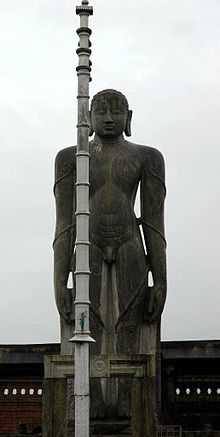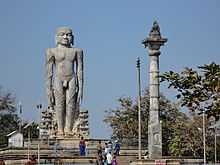Bahubali



Bahubali also called Gommateshwara was the second of the hundred sons of Rishabha, the founder of Jainism in the present half-cycle of time. According to Jain texts, when tirthankara Rishabhdeva decided to became a monk he gave throne to Bharata, eldest of all and made Bahubali, successor to the royal seat.[1] The Adipurana, a 10th-century Kannada text by poet Adikavi Pampa (fl. 941 CE), written in Champu style, a mix of prose and verse and spread over in sixteen cantos, deals with the ten lives of the first tirthankara, Rishabha and his two sons, Bharata and Bahubali.[2][3] According to the Digambaras he was the first human in this half time cycle to attain liberation.[4]
A monolithic statue of Bahubali referred to as "Gommateshvara" built by the Ganga dynasty minister and commander Chamundaraya is a 57 feet (17 m) monolith and is situated above a hill in Shravanabelagola, in the Hassan district of Karnataka state, India. It was built in the 10th century AD.[5] Hundreds of thousands of pilgrims, devotees and tourists from all over the world flock to the statue once in 12 years for an event known as Mahamastakabhisheka. On August 5, 2007, the statue was voted by Indians as the first of Seven Wonders of India.[6] 49% votes went in favor of this marvel.
Meditation
The fight with his brother, Bharata, troubled Bahubali. So after much contemplation, he decided to give up his kingdom and take up the ascetic life. He took to meditation with a thirst for truth, but - it was for ego that he took to meditation on his own. Among monks who accept monastic vows, one must bow to all others who have accepted ascetism previously, regardless of age. Bahubali knew that if he went to Lord Rishabdeva (Aadinatha) for permission to take monastic vows, he would have to bow down to all his 98 younger brothers, who had renounced before him. Bahubali began meditating with great resolve to attain supreme knowledge, but did not succeed because of his ego, which stopped him from visiting his father's court, did not allow him to attain Keval Gyaana,the enlightenment.
However, Bahubali was adamant. He continued his practice unmindful of the vines, ants, and dust which enveloped his body. His sisters Brhami and Sundari were concerned and asked Tirthankar Adinath about their worldly brother Bahubali. Tirthankara Adinatha said, although just moments away from enlightenment, Bahubali could not achieve it because he didn't realise that he was standing on 'the elephant' - Ego. Now understanding his folly, the sisters approached him and said, Oh my dear brother, at least now get down from the elephant. These words from his sisters led Bahubali to question "Am I really standing on any kind of elephant?". From this question he soon realised that the elephant he was standing upon was his pride and ego. Bahubali realised his mistake and shed his pride and ego. He had just lifted his feet to go and bow, when, truth and enlightenment dawned upon him. Blessed with the knowledge of Truth, Bahubali went to see his father who welcomed him. Bahubali began teaching and showing people the right path.
Bahubali is a major figure in Jain hagiography. His story exemplifies the inner strength of Indian culture. He won everything from his brother and could have become an emperor, but he returned everything to the brother. Bahubali is considered the ideal of the man who conquers selfishness, jealousy, pride and anger.
Statues of Bahubali
There are 5 monolithic statues of Bahubali in Karnataka measuring more than 20 feet in height.
- 57 feet at Shravanabelagola in Hassan District in 981 CE
- 42 feet at Karkala in Udupi District in 1430 CE
- 39 feet at Dharmasthala in Dakshina Kannada District in 1973 CE
- 35 feet at Venur in Dakshina Kannada District in 1604 CE
- 20 feet at Gommatagiri in Mysore District in 12th Century CE
Apart from the above, free-standing monolithic statues of Bahubali, there is a supported statue, 84 feet in height, at Bawangaja, Madhya Pradesh.
The Bahubali Atishayakshetra with Bahubali in standing posture is situated on about 50 steps up and 28 feet in high at Kumbhoj, Kolhapur, Maharashtra.
One recently carved statue of Bahubali is located at Dharmasthala. A statue is also being carved in Gujarat.
As recently as 20 years ago, a huge statue of lord Gommateshwara was built at Gommatgiri, 14 kilometres north of Indore, on the Airport road. It is a good miniature copy of the original statue at Shravanabelagola.
The Gommateshvara Bahubali statue at Shravanbelagola
The colossal monolithic statue of Bahubali at Shravanabelagola is 158 km away from Bangalore. This gigantic statue of Bahubali, who is considered a Siddha (one who has attained salvation), is carved out of a single block of granite and stands majestically on top of a hill. For centuries, Shravanabelagola has remained a great pilgrimage center and thousands of pilgrims flock to see the magnificent, gigantic statue. The saint is shown completely nude, in the Jain custom. It is 17 m. (55 ft) high and is visible from a distance of 30 km.
This statue is regarded as one of the largest monolithic statues in the world. It was created around 983 AD by Chavundaraya, a minister of the Ganga King, Rachamalla (Raachmalla SathyaVaak IV 975-986 AD). Neighboring areas have Jaina bastis and several images of the Tirthankaras. One can have a beautiful view of the surrounding areas from the top of the hill. At Shravanabelagola, the Mahamastakabhisheka festival is held once in 12 years, when the image of Gommateshvara is bathed in milk, curds, ghee, saffron and gold coins. This statue is now proposed as World Heritage Site by the Government of India.[7]
Statue of Lord Bahubali (Gomateshwara) at Karkala
Karkala is a town and also the headquarters of Karkala Taluk in Udupi District of Karnataka, India, and is located about 38 km from Udupi and about 480 km from Bangalore. About, 52 km. North-east of Mangalore, is known primarily for the statue of Lord Bahubali (Gomateshwara).
Karkala is well known for its massive 42 feet monolithic statue of Bahubali the Gomateshwara, the son of the first Jain Tirthankar, believed to have been built around 1432 AD. This is a male figure in a naked posture approached by a number of rock-cut steps. Bahubali, a local prince who trounced his brother in a war to win the kingdom, renounced worldly pleasures of life and spent 12 years in meditation, by what time climbers grew all over and around him. Veerapandya Bhairava Raja built this monolithic statue in his honor. A festival with all mighty known as Maha Masthakaabhisheka, sacred bathing of the statue with saffron paste, milk and water, held in every 12 years. During this period thousands of Jain devotees visit this place to carry out the Mahamastakabhisheka. This statue is an awesome sight and is the second tallest in the State.
Mahamasthakabhisheka of Lord Bahubali at Karkala will be held during January 21-31, 2015
The Mahamasthakabhisheka of Lord Bahubali at Karkala will be held during January 21-31, 2015 under the auspices of the Sri Bahubali Swamy Mahamasthakabhisheka Samithi. The towering 41.5 ft. granite monolith of Bahubali - also known as Gommateshwara - is built on an elevated platform on top of a rocky hill, known locally as Gommata Betta. Gommateshwara is also known as Gommata, Gomata and Gomateshwara. The colossus was consecrated on 13 February 1432 A.D. by Veera Pandya Bhairarasa Wodeyar, scion of the Bhairarasa Dynasty, feudatory of the Vijayanagar Rulers.
The Mahamasthakabhisheka (ceremonial anointment) of the statue is done once every 12 years, a Jain religious rite that dates back to ancient times. The ceremonial anointing will be done customarily from the top of a specially constructed scaffolding, when water from 1008 kalashas (pots) will be poured over the Gommata, as a purification rite. The abhisheka (ceremonial bathing) then begins to the heralding of bugles and the beat of drums. Milk from kalashas and large containers is poured on Gommateshwara, followed by clouds of white rice powder. Next, the statue is anointed with coconut water and sugarcane juice. Liquid turmeric and red sandalwood paste then cover the Gommata in hues of amber and mahogany. Next comes the libation of ashtagandha - a combination of eight scented substances - followed lastly by a shower of flower petals. The splendid ceremony ends with the washing of the Gommata with the clear waters of the poorna kumbhas and the arthi of lit lamps. This unique event draws thousands of pilgrims from all over the country as well as across the world, who are enriched by the cultural experience.
Jainism was introduced in Karnataka by Lord Mahaveera in the 6th Century B.C during the course of his travels, when he converted Jivandhara, the king of the Hemangada Country into Jainism. Foretelling a major famine, Monk Bhadrabahu, a leading figure of the Jain religion in the kingdom of Magadha in the 3rd century B.C, led a major migration to Karnataka with Emperor Chandra Gupta Maurya and attained samadhi in the area now known as Shravanabelagola. By the 10th Century, Jainism had become a powerful force in the coastal regions of Karnataka and centres were established all along. With the ascendance of Hinduism, the influence of Jainism waned in the country, though Karnataka still has active Jain pilgrimage centres. Very Excellent Place to visit this noble man.
See also
| Wikimedia Commons has media related to Gomateshvara Statue. |
- Mahamastakabhisheka
- List of statues by height
- List of megalithic sites
Notes
- ↑ Jain 2008, p. 79.
- ↑ History of Kannada literature
- ↑ Students' Britannica India, Volumes 1-5. Popular Prakashan. p. 78. ISBN 0-85229-760-2.
- ↑ Dundas, Paul; John Hinnels ed. (2002). The Jains. London: Routledge. ISBN 0-415-26606-8. p.120
- ↑ Rice 1889, p. 53.
- ↑ "And India's 7 wonders are...". The Times of India. August 5, 2007.
- ↑ TNN Dec 31, 2011, 03.05AM IST (2011-12-31). "Bahubali may get world heritage tag - Times Of India". Articles.timesofindia.indiatimes.com. Retrieved 2012-05-18.
References
- Rice, B. Lewis (1889). Inscriptions at Sravana Belgola: a chief seat of the Jains, (Archaeological Survey of Mysore). Bangalore : Mysore Govt. Central Press.
- Jain, Champat Rai (2008). Risabha Deva (Second ed.). India: Bhagwan Rishabhdeo Granth Mala. ISBN 9788177720228.
Further reading
- Champat Rai Jain (1929). "XI: Bahubali". Risabha Deva - The Founder of Jainism. K. Mitra, Indian Press, Allahabad. p. 139.